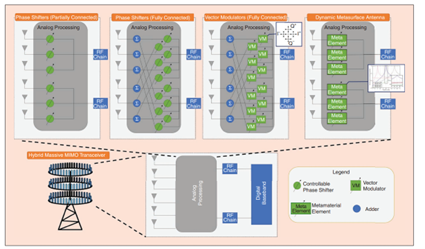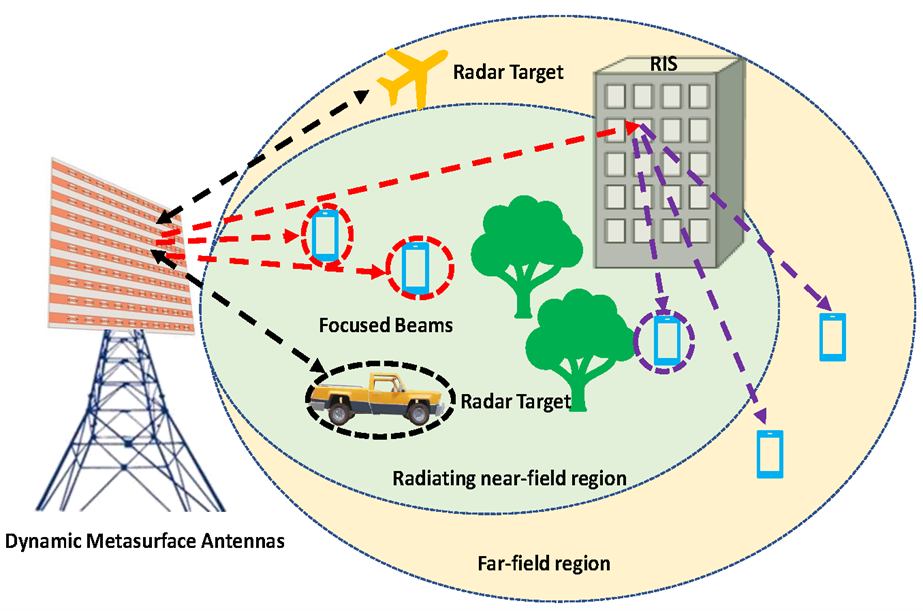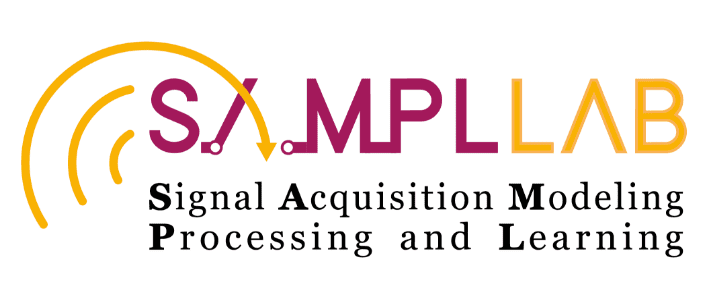Near-Field ISAC & Semantic Communications
With the commercial deployment of 5G networks, researchers in both academia and industry have turned their attention to the development of sixth-generation (6G) wireless networks. These future systems aim to deliver higher data rates, improved energy efficiency, lower latency, enhanced security, and integration of radar functionality. To support these ambitious goals, our group focuses on the following key technologies for 6G: Model-Based Deep Learning Signal Processing, Integrated Sensing and Communication (ISAC), Near-Field Wireless Communications, and Dynamic Metasurface Antennas (DMAs).
Model-Based Deep Learning Signal Processing:
Communication and radar signal processing have traditionally relied on classical statistical modeling techniques. These model-based methods use mathematical formulations that capture underlying physics, prior information, and domain knowledge, providing theoretical guarantees, interpretability, and optimality. However, they are sensitive to modeling errors, rigid under complex or dynamic behavior, and can break down when real systems deviate from assumptions. In contrast, purely data-driven methods, powered by deep neural networks (DNNs) and generic deep learning pipelines, learn model-agnostic representations from large datasets and adapt to unknown environments, achieving excellent supervised performance. However, they require massive data, immense computational resources, and lack interpretability and formal guarantees, limiting their use in resource-constrained or safety-critical scenarios. Model-based deep learning bridges these paradigms by embedding structured models—compressed sensing, digital communications architectures, and state-space tracking—into neural networks. This hybrid approach reduces data requirements, enforces physical constraints for robustness, and retains learning flexibility, delivering efficient, adaptive, and theoretically grounded solutions for communication and radar systems.

Illustration of model-based versus data-driven inference.

Schematic illustration of different hybrid MIMO transceiver architectures and their corresponding analog processing model.
References:
N. Shlezinger, G. Revach, A. Ghosh, S. Chatterjee, S. Tang, T. Imbiriba, J. Dunik, O. Straka, P. Closas and Y. C. Eldar, "AI-Aided Kalman Filters", Submitted to IEEE Signal Processing Magazine, October 2024.
N. Shlezinger, M. Ma, O. Lavi, N. T. Nguyen, Y. C. Eldar and M. Junt, "Artificial Intelligence-Empowered Hybrid Multiple-input/multiple-output Beamforming: Learning to Optimize for High-Throughput Scalable MIMO", IEEE Transactions on Signal Processing, vol. 19, issue 3, pp. 58-67, September 2024.
N. Shlezinger and Y. C. Eldar, "Model-Based Deep Learning", Foundations and Trends in Signal Processing, vol. 17, issue 4, pp. 291–416, August 2023.
Integrated Sensing and Communication (ISAC):
In next-generation communication systems, sensing capabilities are expected to support applications such as intelligent transportation, smart cities, and industrial automation. ISAC, also known as Dual-function Radar and Communications (DFRC), merges radar and communication functionalities within the same system. This integration enables spectrum sharing, reduces hardware complexity, and improves power efficiency. To this end, we pursue two complementary ISAC research directions: Bi-static MIMO ISAC for URLLC Prioritization: We propose a bi-static MIMO ISAC system to detect targets and trigger ultra-reliable low-latency communication (URLLC) within ongoing eMBB transmissions. In particular, we deploy a sensing receiver to sense targets and employ dirty-paper coding to mitigate interference, optimizing the rate–reliability–detection trade-off in the finite-blocklength regime. Agile Radar with Index Modulation and Precoder Design: We investigate embedding digital communication methods into radar operations to ensure reliable joint functionality with minimal interference. In particular, we explore the use of agile radar combined with index modulation and the design of dedicated precoders for simultaneous radar and communication support.
Extended Line of Sight based on Joint Radar and Communication.

MIMO ISAC System for Ultra-Reliable and Low-Latency Communications.
References:
H. Nikbakht, Y. C. Eldar and H. V. Poor, "A MIMO ISAC System for Ultra-Reliable and Low-Latency Communications", arXiv:2501.13025, January 2025.
F. Liu, Y. Cui, J. Xu, T. X. Han, Y. C. Eldar and S. Buzzi, "Integrated Sensing and Communications: Towards Dual-functional Wireless Networks for 6G and Beyond", IEEE Journal on Selected Areas in Communications, vol. 40, issue 6, pp. 1728-1767, June 2022.
T. Huang, N. Shlezinger, X. Xu, Y. Liu and Y. C. Eldar, "MAJoRCom: A Dual-function Radar Communication System Using Index Modulation", IEEE Transactions on Signal Processing, vol. 68, pp. 3423–3438, 2020.
Demos: https://www.weizmann.ac.il/math/yonina/software-hardware/hardware/joint-radar-communications-systems
Near-Field Wireless Communications:
With the use of large-scale antennas and higher frequencies, future wireless systems will increasingly operate in the near-field (Fresnel) region. Unlike the far-field regime characterized by plane wave propagation, the near-field supports spherical wavefronts and distance-dependent radiation patterns. This makes beam focusing—targeting a specific location rather than a direction—feasible, enabling multiple coexisting links even at similar angles. Our research explores how beam focusing in near-field conditions enhances spatial multiplexing and supports new communication paradigms for 6G.

Near-Field Wireless Communications.
References:
H. Zhang, N. Shlezinger, F. Guidi, D. Dardari and Y. C. Eldar, "6G Wireless Communications: From Far-Field Beam Steering to Near-Field Beam Focusing", IEEE Communications Magazine, vol. 61, issue 4, pp. 72–77, April 2023.
H. Zhang, N. Shlezinger, F. Guidi, D. Dardari, M. F. Imani and Y. C. Eldar, "Beam Focusing for Near-Field Multiuser MIMO Communications," in IEEE Transactions on Wireless Communications, vol. 21, no. 9, pp. 7476-7490, Sep. 2022.
Dynamic Metasurface Antennas (DMAs):
DMAs offer a low-cost, energy-efficient alternative to traditional large-scale antenna arrays. As practical implementations of large intelligent surfaces, DMAs allow for programmable control of transmit/receive beam patterns while enabling advanced analog signal processing and RF chain reduction. Their compact and dense structure supports enhanced communication performance through spatial diversity and reduced interference. We investigate the application and optimization of DMA in wireless communication and power transfer to jointly design beamforming and energy-focusing patterns that maximize spectral efficiency and wireless power delivery under practical hardware constraints.

Dynamic Metasurface Antennas (DMA).
References:
N. Shlezinger, G. C. Alexandropoulos, M. F. Imani, Y. C. Eldar and D. R. Smith, "Dynamic Metasurface Antennas for 6G Extreme Massive MIMO Communications", IEEE Wireless Communications Magazine, vol. 28, issue 2, pp. 106-113, April 2021.
H. Zhang, N. Shlezinger, F. Guidi, A. Guerra, D. Dardari, M. F. Imani and Y. C. Eldar, "Near-Field Beam-Focusing for Wireless Power Transfer With Dynamic Metasurface Antennas", IEEE Internet of Things Journal, 2025.
Zhang, H., Shlezinger, N., Guidi, F., Dardari, D., Imani, M. F., & Eldar, Y. C. (2021, June). Beam focusing for multi-user MIMO communications with dynamic metasurface antennas. In ICASSP 2021-2021 IEEE International Conference on Acoustics, Speech and Signal Processing (ICASSP) (pp. 4780-4784). IEEE.

